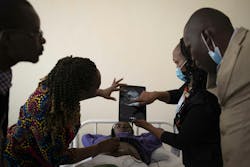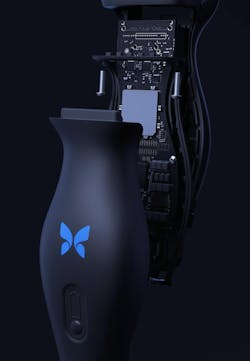Pocket-Sized Ultrasound: From Medical Device Design to Delivery
In sub-Saharan Africa, approximately 202,000 mothers and 27 of every 1,000 infants face mortality due to complications in childbirth, primarily due to inadequate healthcare accessibility. The World Health Organization (WHO) reports that the high disease burden during pregnancy exacerbates these risks.
Machine Design spoke with Nevada Sanchez, co-founder and chief innovation officer of Butterfly Network, to explore the significance of miniaturized ultrasound technology as a life-saving tool. We focused on the engineering challenges and innovations that make it a viable option for low-resource settings.
Advancements in Medical Imaging
Butterfly Network Co., co-founded by Sanchez in 2011, has pioneered the development of pocket-sized ultrasound devices that offer full imaging capabilities. The engineering challenges addressed by the company revolve around designing a device small enough to fit in a pocket while retaining the functionality of a traditional ultrasound machine. The goal was to create an affordable, accessible solution that ensures quality medical imaging, especially in underprivileged regions.
Sanchez says that just as photography evolved from film to digital, ultrasound technology needs similar innovation. Their approach integrates ultrasound technology onto a semiconductor chip, which reduces costs and increases accessibility.
Developing a whole body imager that is both compact and capable required the team to overcome some technical challenges. Sanchez said that the project involved fitting 9,000 channels onto a chip the size of the two postage stamps, including more than 1,000 analog-to-digital converters and necessary processing capabilities. This feat is equivalent to handling 25,000 4K video streams simultaneously within a device optimized for size and performance.
“And that wasn't even the hardest part,” he said, “because in order to really make this truly integrated, not only the electronics have to fit on there. We actually had to build micro machines on top of the wafer.”
These are micro machine drums, mechanical structures or MEMS (micro-electromechanical systems), for short, he said. Butterfly’s trademarked Ultrasound-on-Chip Technology integrates thousands of transducer elements directly onto the circuits that control them at the wafer level.
The engineering team faced some hurdles in integrating micro machines onto the wafer, Sanchez said. The design needed to merge mechanical components with the electronic architecture, effectively moving away from traditional designs that use separate crystals and cables. This required the development of a unique semiconductor processing technique tailored for ultrasound applications.
“Once we had the chip solved, there was everything else about the probe,” Sanchez said. “It had to be ergonomic, usable, functional, performant, manufacturable, reliable, cost-effective…so there are no shortage of challenges beyond solving that one big, massive [challenge] of making the first ultrasound system on a chip.”
Design Software Utilization
The integration of miniaturized ultrasound technology into healthcare systems represents a big leap in engineering innovation aimed at solving global health disparities by focusing on design. The third-generation Butterfly iQ3 handheld ultrasound device received the Best Medical Technology Award at the 2024 Prix Galien USA Awards by the Galien Foundation. To create something so sophisticated yet so miniaturized took some serious design software.
Butterfly Network uses several design software tools, including Solidworks, Fusion 360, Ansys, COMSOL Multiphysics and Git version control.
Solidworks. This industry standard CAD software is used for mechanical design and simulations. Solidworks helps engineers model the intricate components of the ultrasound device, allowing for detailed analyses of mechanical performance and ergonomics. The software's capabilities and thermal simulations were especially important for assessing heat management and compact designs.
With the power of artificial intelligence (AI ) and machine learning, the software’s Design Assistant learns from the user and makes suggestions based on the design, automating and removing tedious and repetitive tasks. Every time the parametric, sheet metal and structure design tools are used in Solidworks’ Cloud, the AI learns and can make better recommendations based on what the users like to design, continually evolving and learning from those choices.
Fusion 360. This tool serves multiple purposes within the engineering department, especially for rapid prototyping. Engineers use Fusion 360 for creating test jigs and fixtures, leveraging its computer-aided manufacturing (CAM) capabilities to manufacture parts quickly. This agility is especially important during the prototyping phases where multiple iterations are tested based on real-time feedback.
READ MORE: The Evolution of Medical Technologies Yields Life-changing Results
ANSYS and COMSOL Multiphysics. For advanced analysis, particularly concerning MEMS and micro machining, Sanchez says that simulation software from ANSYS and COMSOL Multiphysics is employed. These tools enable the team to simulate the mechanical performance of the tiny ultrasound transducers, ensuring that they meet engineering standards before physical prototypes are created.
Git Version Control. Collaboration within the engineering teams is facilitated through a distributed version control system such as Git, ensuring that code and design files are managed effectively across different groups. This is especially important for software development related to the ultrasound device, where multiple engineers may work on different aspects concurrently.
Of course, it's important to understand the end-user, especially in healthcare settings, Sanchez says. The design focused extensively on user-centered principles to ensure functionality and comfort for clinicians. For example, he said, the device’s ergonomic design was optimized to allow healthcare professionals to maneuver it easily, reducing the potential for repetitive stress injuries that conventional ultrasound machines often cause.
Thermal efficiency was another consideration given the heat that is generated in compact designs. Ensuring the device remains compliant with safety standards, particularly in hot climate climates like sub-Saharan Africa, required innovative thermal management solutions. They analyzed thermal conductions and pathways to maintain performance while adhering to safety guidelines, according to Sanchez.
“Once we did launch the device into the field, we put in a lot of analytics into the device and the software so we actually understand how our user base is actually using the device,” he said. “We know what modes are being used. If people are reaching their thermal shut-off limits, we know when that's happening and what they were doing before that happens.
“And so we really understand what the problems [are] that are happening in the field through all of these analytics we’re able to collect,” he added.
They also used surveys to understand any complaints that users might have had and use those to improve future product development.
Designed to Comply, Built to Save
Sanchez talked about the importance of incorporating regulatory compliance considerations from the outset. By anticipating potential hurdles, including battery safety and long-term reliability, the team devised a design framework that would facilitate a smoother regulatory approval process. Field testing was integral to this process, he said.
Engaging key opinion leaders and clinicians early in the development allowed for practical feedback that directly influenced design iterations. This collaboration ensured that the final product genuinely addressed the needs of healthcare providers in challenging conditions.
Butterfly Network's mission is to democratize healthcare, scanning every patient with only one probe to assess the heart and lungs, monitor pregnancy, perform trauma evaluations and many more applications with high patient impact, particularly in limited resource settings in rural America and globally. Every 90 sec., a mother dies from childbirth complications in developing regions, highlighting the stark difference in healthcare access compared to developed nations’ availability of ultrasound. Technology can provide timely information regarding pregnancy risks such as breech positioning or placenta previa, Sanchez said, allowing for timely interventions that save lives.
Through a partnership with the Gates Foundation, the Butterfly Network distributed 1,000 devices in Kenya, training midwives to perform scans. Each trained midwife has significantly contributed to saving lives every month by identifying high-risk pregnancies. Collectively, more than 1 million scans have been performed, addressing a critical deficit in medical imaging technology in regions where it was previously nonexistent.
Toward a Sustainable and Scalable Future Using AI
To expand the reach of medical technologies, sustainability and scalability in manufacturing processes are needed. Butterfly Network is not only focusing on the production of cost-effective devices, but also investing in comprehensive training models. AI-enhanced software applications are designed to assist healthcare providers in becoming proficient in ultrasound technology with minimal direct supervision.
Sanchez says apps like ScanLab allow users to receive real-time feedback while they learn, enabling them to effectively perform ultrasound scans without extensive prior experience. This approach helps propagate advanced healthcare capabilities in low-resource settings around the world.
As engineering advancements continue, the potential applications for miniaturized ultrasound technology extend beyond maternal health. Sanchez said the same ultrasound chip technology can be adapted to develop wearable devices for continuous monitoring of health metrics.
Also, the engineering innovations from this project are opening the door for applications in various fields, including aerospace for structural integrity testing and brain computer interfaces for neurological assessments.
About the Author
Sharon Spielman
Technical Editor, Machine Design
As Machine Design’s technical editor, Sharon Spielman produces content for the brand’s focus audience—design and multidisciplinary engineers. Her beat includes 3D printing/CAD; mechanical and motion systems, with an emphasis on pneumatics and linear motion; automation; robotics; and CNC machining.
Spielman has more than three decades of experience as a writer and editor for a range of B2B brands, including those that cover machine design; electrical design and manufacturing; interconnection technology; food and beverage manufacturing; process heating and cooling; finishing; and package converting.
Email: [email protected]
LinkedIn: @sharonspielman
Facebook: Machine Design
YouTube: @MachineDesign-EBM

Marie Darty
Group Multimedia Director, Engineering & Manufacturing
Marie Darty is a digital media professional currently serving as the group multimedia director for the Manufacturing & Engineering Group at Endeavor Business Media. A graduate of Jacksonville State University, she earned her Bachelor of Arts in digital communication with a concentration in digital journalism in December 2016. In her current role, she leads the strategy and production of multimedia content, overseeing video series planning and editing. Additionally, she oversees podcast production and marketing of multimedia content.



